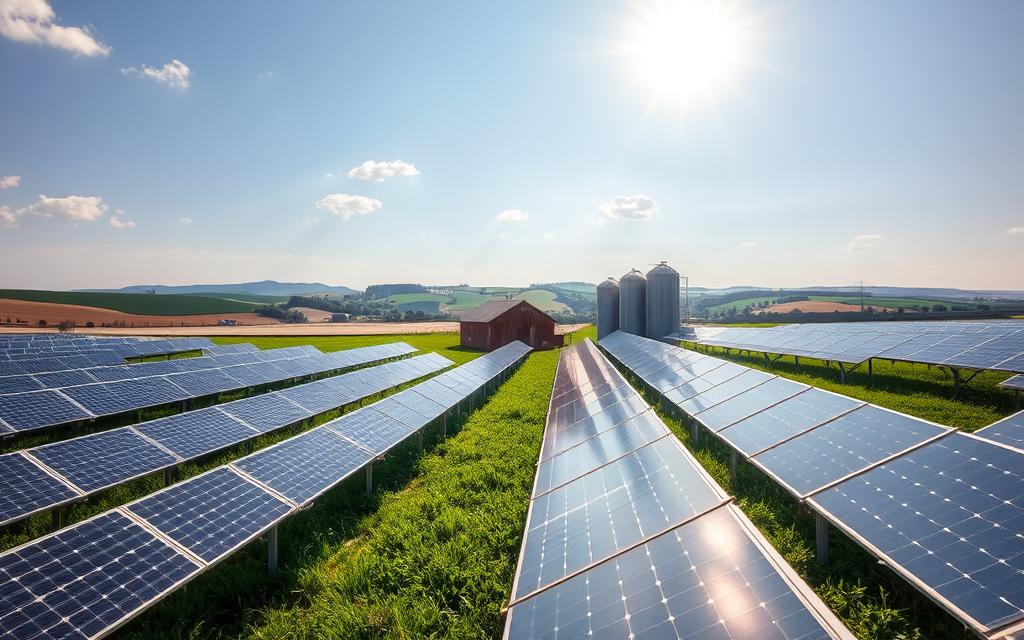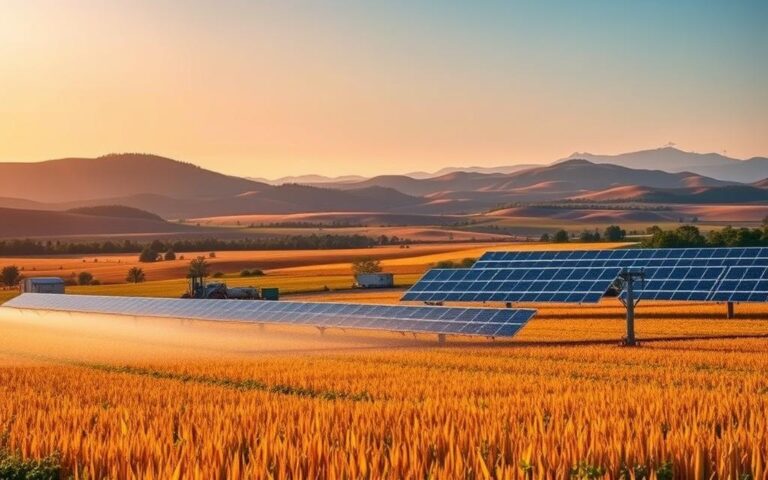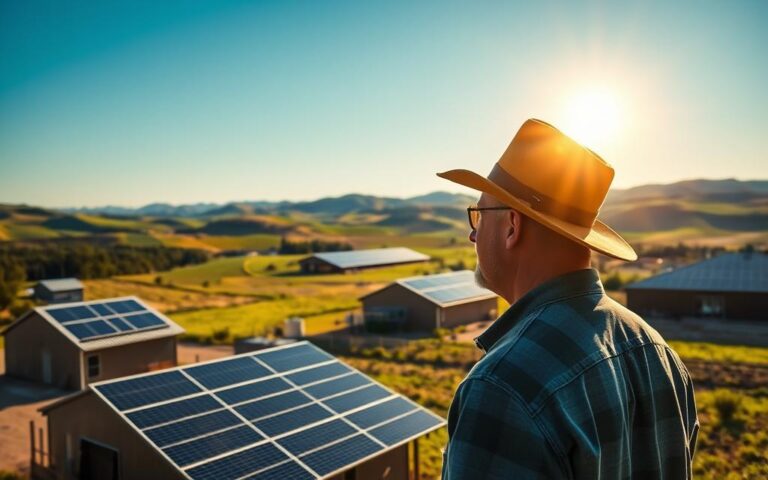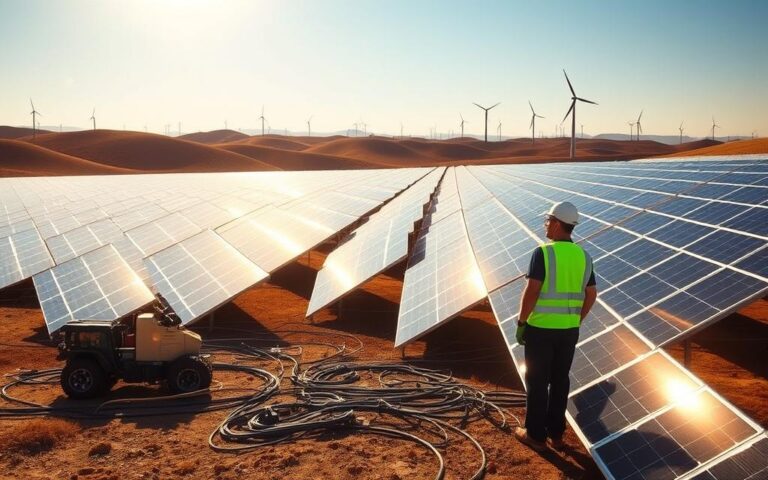Did you know solar energy can cut farmers’ costs by up to 50%? In the United States, solar energy for farms is becoming a big deal. It’s a shift towards more sustainable energy.
Farmers are using solar energy to boost productivity and reduce their environmental footprint. This is especially important as climate concerns grow. Solar energy is helping farmers work better and cleaner.
New solar technology makes it easier for farms to use solar power. This leads to two big wins: making energy and growing better crops. This change shows how much the agricultural sector cares about the environment. It’s also meeting the need for clean energy.
Solar energy for farms in the USA is leading to a greener future. It’s a key spot where sustainability and agriculture meet.
The Rise of Solar Energy in Agriculture
The agricultural sector in the United States is changing fast thanks to solar energy. Farmers are seeing the benefits of using renewable energy. This move helps them meet sustainability goals and get financial benefits, making solar energy a good choice for many farms.
Growing Demand for Renewable Energy
Concerns about climate change are making people want renewable energy more. This is true for farmers too. Solar energy for farms in the USA is a way for farms to help the environment and have a reliable energy source.
Advancements in Solar Technology
New solar technology has changed farming a lot. Over the last ten years, solar systems have gotten cheaper. This makes them easier for farmers to use.
Studies show more farmers are choosing sustainable farming. These new technologies help farmers use solar energy better. This leads to more energy independence for farms.
| Year | Annual Solar Energy Growth (%) | Cost Reduction (%) |
|---|---|---|
| 2013 | 15 | 5 |
| 2018 | 20 | 20 |
| 2023 | 25 | 40 |
These numbers show solar energy in farming is growing fast. They also show solar installations are getting more affordable. As farmers use these new technologies, they can make their farms more sustainable.
Understanding Agrivoltaics
Agrivoltaics is a new way to use land for both solar energy and farming. It lets farmers grow crops and make clean energy at the same time. This is good for farmers and the planet, making it a key part of sustainable living.
Definition and Benefits of Agrivoltaics
Agrivoltaics combines solar panels with farmland. This lets crops grow in the shade and makes clean energy. It’s a smart way to use land, helping both farming and energy production.
Types of Agrivoltaic Systems
There are different ways to set up agrivoltaic systems. These include:
- Elevated Systems: Solar panels are placed above the crops, giving them shade and making energy.
- Inter-Row Systems: Crops grow between the rows of solar panels, using the land well.
- Hybrid Systems: A mix of elevated and inter-row designs, using the land to its fullest.
| Type of Agrivoltaic System | Key Features | Advantages |
|---|---|---|
| Elevated Systems | Panels above crops | Reduces heat stress on crops |
| Inter-Row Systems | Crops grow between panel rows | Maximizes land use and productivity |
| Hybrid Systems | Combination of elevated and inter-row | Versatile and adaptive to different agricultural practices |
Solar Energy for Farms USA
Adding solar energy systems to farms can really boost their economy. By using renewable energy, farmers can save a lot of money. This helps them make more profit.
Putting up solar panels cuts down on energy costs. This gives farmers a big financial break.
Cost Savings for Farmers
Solar energy is great for saving money on farms. It lets farms make their own electricity. This cuts down on utility bills a lot.
This change helps farmers save money right away. It also lets them use their resources better. This makes farming more sustainable.
Increasing Farm Income Through Energy Sales
When farms make more electricity than they use, they can sell it. This gives farmers another way to make money. It turns solar energy into a way to earn income.
Many farmers are now leasing solar panels. This brings in more money than farming itself. Solar energy is becoming a smart financial choice for farms.
Environmental Benefits of Solar Energy
Using solar energy in agriculture brings many environmental benefits. One big plus is less carbon emissions from fossil fuels. This helps fight climate change and makes farming more eco-friendly.
Reducing Carbon Emissions
Switching to solar energy cuts down on greenhouse gases. This is key in the fight against global warming. It also makes the air cleaner, which is good for our health.
Enhancing Crop Resilience
Solar panels create shaded areas that help crops grow better. As weather gets wilder, crops need to handle drought and heat. Research shows that crops in shade grow stronger and produce more, helping farms stay productive even when it’s tough.
Challenges Facing Solar Adoption in Agriculture
Switching to solar energy in farming comes with big hurdles. Land use conflicts are a major issue. Solar farms often take over farmland, threatening food supply and changing how land is used.
Also, the cost of setting up agrivoltaic systems is high. These costs are more than traditional solar projects. This is because they need special designs and tech.
Land Use Conflicts with Agriculture
When solar farms and farming compete, problems arise. Farmers worry about losing land that’s vital for food. Finding a balance between solar energy and farming is key for a sustainable future.
Installation Costs of Agrivoltaic Systems
Agrivoltaic systems have many benefits, but they’re expensive to set up. They need special designs that work with farming. This makes starting them costly, especially for farmers without enough money.
Lawmakers must help by creating policies that support solar energy and farming. This way, they can encourage solar adoption while keeping farming strong.
Case Studies of Successful Solar Integration
The Pacific Northwest is a leader in using solar energy in farming. It shows many successful projects that mix solar power with agriculture. These projects prove that solar tech works well and farming can meet energy needs without losing productivity.
Examples from the Pacific Northwest
In the region, several projects show how solar can help crops and make energy. For example, solar panels were added to blueberry farms in Washington. Growers saw better yields because the shade protects them from very hot or cold temperatures.
Outcomes of Agrivoltaic Projects
These projects have big wins for both the environment and the economy. Farmers get more from their crops and use less traditional energy. Here’s a look at some key projects:
| Project Location | Crop Type | Yield Increase (%) | Energy Generated (kWh/year) |
|---|---|---|---|
| Oregon | Potatoes | 15 | 20,000 |
| Washington | Blueberries | 10 | 25,000 |
| Idaho | Cherries | 12 | 18,500 |
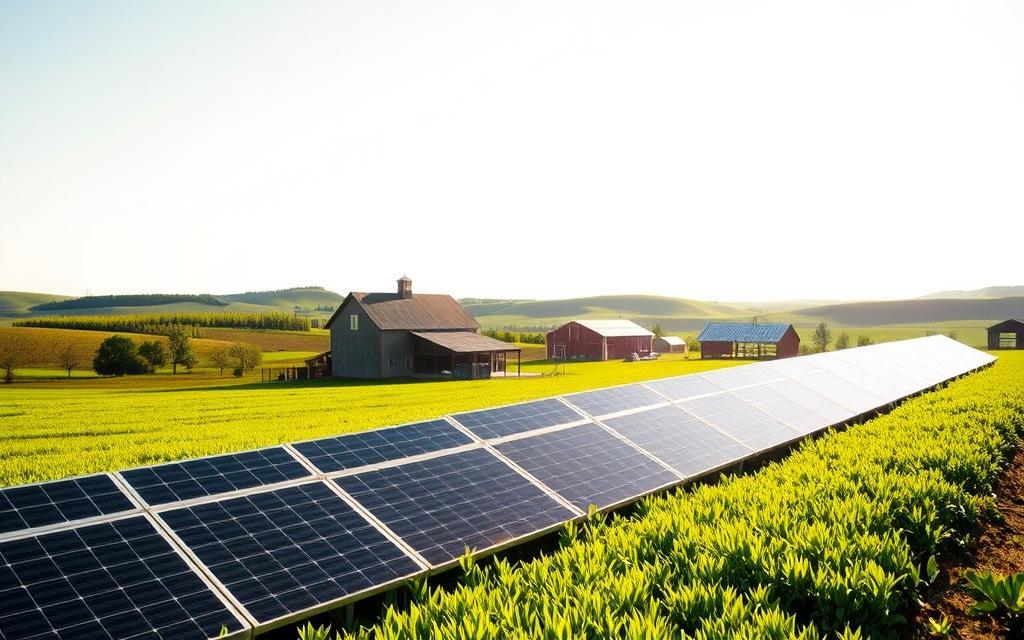
These examples show the power of solar in farming in the Pacific Northwest. They offer a guide for future projects and push farming towards sustainable energy.
Impact on Farm Workers
The move to solar energy, especially with agrivoltaic systems, greatly affects farm workers. These changes alter their daily lives and improve working conditions in farms. It’s a big step towards bettering their environment.
Mitigating Extreme Heat Exposure
Farm workers often deal with extreme heat, which can harm their health. Solar panels in farming create shaded areas, protecting them from the sun. This makes their work safer and healthier.
Improving Working Conditions
Solar energy helps make farm work better. It makes tasks easier, reducing physical strain. Workers are happier and live better lives. This shift towards green farming is a big step forward.
Government Policies Supporting Renewable Energy
Government policies are key in boosting renewable energy in farming. They push farmers to use solar energy. This includes financial help and rules to encourage the use of solar panels.
Incentives for Solar Installations on Farms
There are many solar incentives for farms to help farmers switch to solar. Laws like the Infrastructure Investment and Jobs Act and the Inflation Reduction Act give tax breaks and grants. These help lower the cost of solar panels, saving farms money in the long run.
State and Federal Renewable Energy Goals
States and the federal government have set big renewable energy goals. They want to cut down on greenhouse gases and use more clean energy. Farms are encouraged to use solar technology to meet these goals.
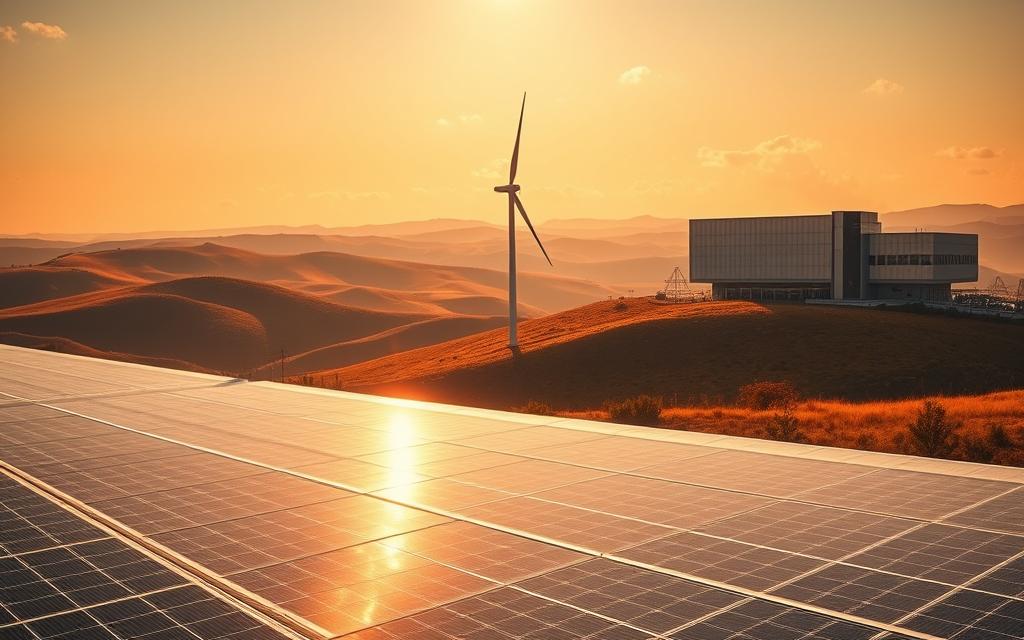
| Policy Initiative | Type | Benefit |
|---|---|---|
| Infrastructure Investment and Jobs Act | Federal Policy | Provides funding for solar panel installation |
| Inflation Reduction Act | Federal Tax Credit | Offers tax benefits for renewable energy projects |
| State Renewable Energy Portfolio Standards | State Policy | Mandates renewable energy adoption in various sectors |
Thanks to these policies, renewable energy in farming has a bright future. Farmers get financial help and help make our energy cleaner.
The Future of Solar Energy in Agriculture
The future of solar energy in agriculture looks bright. It’s filled with chances for new ideas and being green. The growth of agrivoltaic systems, which mix farming with solar power, is a big part of this. As tech gets better, these systems will help farms grow more and protect the environment.
Potential for Growth in Agrivoltaic Systems
The agrivoltaic sector is set to grow a lot. Farmers want to make more money, and solar panels on farms are a good way to do it. This method makes clean energy and uses land well, letting crops grow under solar panels.
More and more people are seeing the good in using land for both farming and solar power. This includes farmers, scientists, and government officials. They all see the value in making the most of land for farming and solar energy.
Research and Development Opportunities
Research and development are key to solar energy’s future in farming. Studies on growing crops better and making solar power more efficient are crucial. By investing in R&D, we can create new agrivoltaic designs, better energy storage, and smart farming tech.
These innovations will help farms and renewable energy work together better. They will support sustainable farming and energy practices.
Conclusion
Using solar energy for farms in the USA is a big step towards sustainable farming. It helps farmers save money and make more money. This change makes farming more affordable and helps the environment.
Even though there are challenges like high costs and land issues, new solutions are coming. Agrivoltaic systems and government help offer hope. These steps help farming keep up with today’s environmental needs.
Choosing solar energy shows American farming’s commitment to being green. It’s a key part of using renewable energy. This choice helps fight climate change, making our planet healthier for farmers and consumers of the future.

